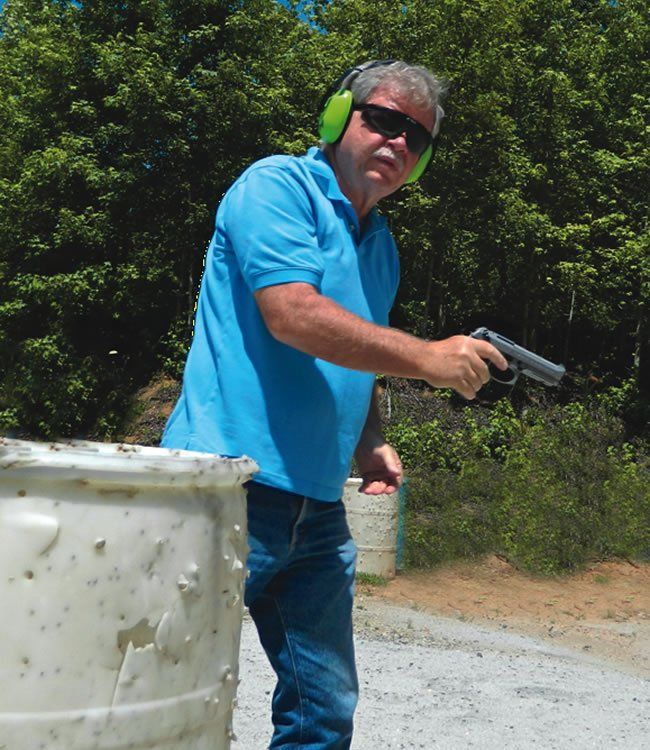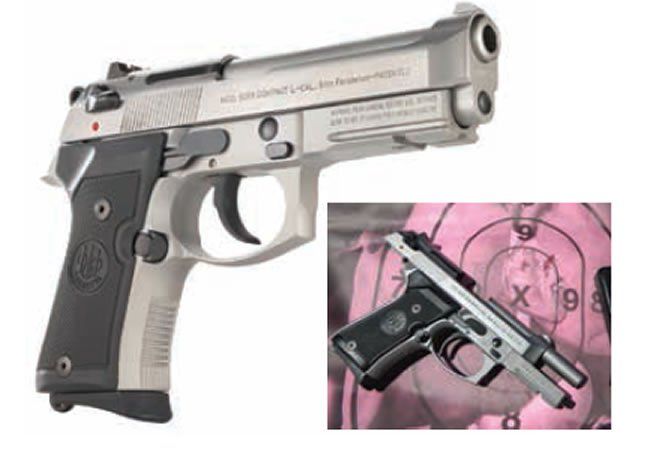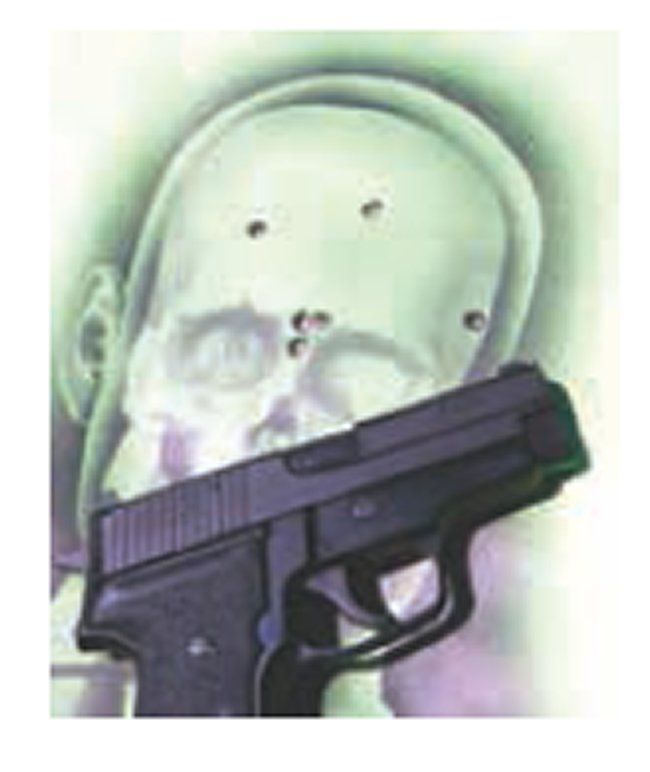Two pistol makers that have knocked heads in police and military competitions for more than 30 years are SIG Sauer and Beretta. The Beretta 92 and the SIG P226 engaged in a hotly contested and much debated U.S. Military trial. After the dust settled, Beretta won that lucrative contract. However, the Navy did not accept the Beretta and instead adopted the SIG. American police agencies have used both in large numbers, with the SIG often hampered by a higher price. Recently, the French Army and police forces gave SIG the largest single peacetime order for handguns in history. Certainly, both makes enjoy enviable reputations. But at Gun Tests, all makers start on the same footing, reputation or not.

The raters were led toward this test by external factors. In one case, a family member was looking for a good, clean SIG P228 as a carry gun. Since the P228 is out of production, replaced by the heavier P229 or M11 A1, the SIG P228 would have to be a used gun. (Occasionally, a new-in-the-box P228 is seen at a premium.) The other instigator was an e-mail from Afghanistan. A young soldier told her father-in-law, I want a Beretta for my own when I get home! After two tours in Iraq and the tour in Afghanistan, this well-trained soldier had great respect for the Beretta. However, she did ask if there were a shorter, lighter version of the pistol.There is a compact version of the 92FS, but it is seldom seen. The question was, would the self-defense shooter be better off with the new Beretta or the used SIG, if each could be found within a few dollars of the other?

This would be a tough contest. Among our raters, one has over 20 years of police experience, including training several agencies on the SIG. Another is a military intelligence officer who has deployed the Beretta from Europe to the Pacific and just returned from 14 months with the Beretta as a daily companion. Other raters had experience with both pistols. So the deck wasnt stacked in favor of either handgun.
Common aspects of the guns include aluminum frames and steel slides. Each features a double-action first-shot trigger. Each features a 13-round magazine. Beyond those areas, lock-up differs. The SIG uses angled camming surfaces to unlock, and the barrel hood butts into the slide. The Beretta locks and unlocks via an oscillating wedge. There are differences in the decockers, and handling feels very different. Heres how our shooters rated them when the pistols were shot head to head:
Beretta 92A1 Compact Inox
J90C9F20 9mm Luger, $650
CheaperthanDirt.com lists this pistol at $591.76, so we include it as a national pricing source, but we paid $650 and tax for the Beretta at a local shop in South Carolina. The Beretta 92C is a much less common pistol than the SIG compact. The 92FS Inox compact version features a stainless-steel slide. The slide closely matches the anodizing of the aluminum frame. The loaded-chamber indicator, extractor, trigger, hammer, takedown lever, magazine-release button, and safety levers are finished in a contrasting black color.
When we first handled the pistol, we noticed the slide-to-frame fit was tight with virtually no lateral play. The rear sight was black. The stainless front sight was an integral part of the slide. The three-dot sight arrangement was bright red, a good choice for this finish.
The double-action trigger was smooth but heavy at about 14 pounds. The single-action trigger broke cleanly at 5.1 pounds. The distance from the face of the trigger to the inside of the trigger guard was about 1.125 inch, compared to 1 inch in the SIG, and the curve of the Berettas trigger allowed easier gloved-hand use, our testers said.
Moving to the frame, Beretta has done a credible job in downsizing the grip frame. The raters familiar with each felt that the 92C is more comfortable than the full-size Beretta. It fit most hands well. A female rater felt trigger reach was improved. The plastic checkered grips were thinner than in on the service-size handgun. (Beretta ads advertise rubber grips, but ours were hard plastic.) The grips were secured with hex-head screws. The rear strap and front strap were each checkered in a similar fashion. This checkering was given high grades by every rater. The grip abrasion and adhesion were excellent, we thought, offering excellent control of the pistol even with sweaty or cold hands.
The slide-mounted decocker of the Beretta wasnt as ergonomic as the SIGs, we thought. However, the Beretta featured a manual safety. The pistol is decocked, and if desired, the lever is left in the down position for on Safe carry. Using a strong straight-thumb technique, the shooter may switch the Beretta to Fire and Safe relatively quickly. So, if you prefer a manual safety, then the Beretta is the top pick. If you wish to use only the decocker, the safety may be ignored. Those who prefer the simplicity expressed by the original German police trials will find the SIG more attractive.
During the firing test, the Beretta was drawn from concealed carry and fired at man-sized targets at 5, 7, and 10 yards. We fired 100 rounds of Black Hills 115-grain remanufactured loads during this test. The pistol was new out of the box. There were no malfunctions of any type during the combat-type firing. Both pistols are 9mm handguns weighing about 30 ounces, so recoil was never uncomfortable. The Beretta is slightly longer than the SIG but shorter in height. We found the long double-action trigger of the Beretta limited first-shot hits. Some raters, such as our military officer, did much better than others. He achieved speedy center hits at 15 yards on demand. Once the first shot was broken, the Beretta showed excellent control. Rapid-fire accuracy was deemed better than the SIG due to the Italians longer barrel, slightly heavier weight, and longer sight radius. The SIG had the advantage in a smoother first shot, however.
In bench accuracy, the Beretta showed good results. The best single effort was a 1.5-inch group at 25 yards with the Black Hills 124-grain JHP, with the average for this load 2.0 inches. This is excellent for a compact 9mm handgun. The Beretta also showed approximately a 45-fps average lead in velocity for every load we shot.
The Beretta takes down with a lever on the left side of the frame. A plunger on the right side of the frame is pressed to allow the lever to move. The slide is taken off the frame, the recoil spring and guide lifted out, and the barrel removed. Care must be taken to reposition the locking wedge if it is allowed to move out of battery during disassembly. The SIGs disassembly is slightly easier and faster. The SIG requires only that the lever be rotated, and the simpler angled camming surfaces do not require repositioning upon reassembly. The SIG is perhaps 5 seconds faster in assembly.
Our Team Said: While the SIG is a good combat gun, the Berettas stainless-steel finish and the ability to mount a combat light give it greater utility as a carry gun and home-defense pistol. We feel that the Beretta is the better buy based on its accuracy, efficiency, and combat ability.
SIG Sauer P228 9mm Luger,
$600 (used)
The P228 was purchased by one of the raters at his local pawn shop. While he first thought he was paying top dollar for a used pistol, a search of various gun websites shows most are asking more for the P228. Just the same, the P228 came with a total of six magazines, although two were the older 10-round types.
The pistol was in good shape and showed little in the way of finish wear. The pistol slide serrations were rated superior to the Beretta, as noted when loading the handguns. The handy frame-mounted decocker was also easier to use well. The sights were good, with white-bar-dot von Stavenhagen outlines. The front strap was striated, and the rear portion of the wraparound grip was nicely pebbled. While not as aggressive as the Beretta, the SIGs pattern abrasion was fine.
The greatest advantage of the SIG over the Beretta was the trigger action. The double-action trigger press was smooth at about 10 pounds. The single-action press of the SIG was a smooth 4.5 pounds. The difference in the smoothness of the trigger was apparent in rapid-fire drills. The SIG was faster to an accurate first-shot hit than the Beretta. The P228 was also controllable in rapid fire, but the heavier, longer Beretta simply had the advantage in mass. One rater, a former police instructor, noted that recruits often rode the thumb on the SIG slide release and caused the slide to fail to lock open on the last shot. With the grip design of the P228, this practically never occurs and did not occur during our testing. In firing 100 rounds of Black Hills 115-grain FMJ remanufactured loads, the pistol never failed to feed, chamber, fire, or eject. Any function concerns relating to this used gun were swept away with this firing test.

The SIG pistol proved to be accurate. The single best group was a 1.7-inch cluster with the Fiocchi 147-grain JHPs, with the average 2.1 inches. The Beretta slightly edged the SIG on accuracy overall; however, the SIG beat the Beretta with the 147-grain load. The Beretta also delivered greater energy (Black Hills 124-grain JHPs) at 338 foot-pounds, with the SIG behind at 321 foot-pounds. To further proof the handguns, we fired a single 50-round box of +P ammunition through each – Winchester 124-grain JHP +P loads. The increased slide velocity of +P loads may result in an inability of the magazine to keep up with slide velocity. Both pistols performed as reliably as with any other load. The Beretta was the more comfortable handgun to fire with this heavy load, which generated 1210 fps from the Beretta and 1179 fps from the SIG.
On another note, one of the raters carried the SIG between range trips as his sidearm. Since we did not have a custom holster on hand at the time, a fabric holster with a spring-steel metal belt clip – but no sweatguard – was used. The test was conducted in July, and perspiration took its toll. When the SIG was unholstered for range work, it was rusted! It cleaned up, but there is a lesson here. The obvious one is that a sweat guard is needed on a holster. However, many of us make do with an inexpensive holster until we decide we are keeping the gun. As far as corrosion resistance, stainless steel is superior to blued steel.
Our Team Said: In this head to head, we thought the SIG P228 was a good handgun – reliable, controllable, and accurate. Range performance is important, and the SIG left little to be desired in that area. But practical considerations, including exposure to the elements, day-to-day carry, practical accuracy, and a warranty are important advantages of the Beretta. Also, the raters felt that a handgun left at home ready with a manual safety is a plus, and the presence of a light rail on the 92C helped it, too.
Written and photographed by Bob Campbell, using
evaluations from Gun Tests team testers. GT




























